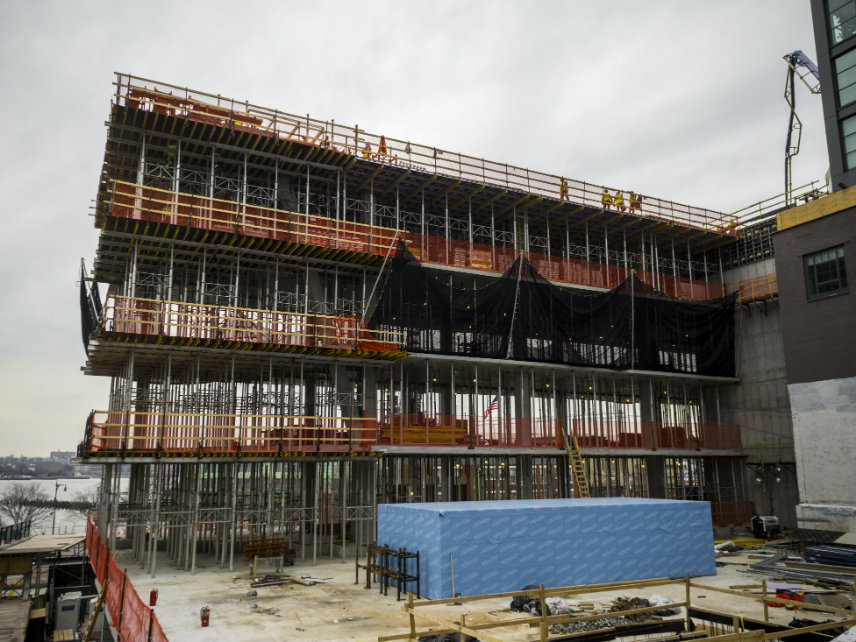Trump's Tariffs Will Make Housing More Unaffordable
Steel tariffs are likely to make prices rise further, particularly in markets where housing demand is already outpacing supply.

Nearly half of America's steel imports are used for construction. New tariffs on that imported steel will hurt construction workers and drive up the price of housing.
President Donald Trump imposed a 25 percent tariff on all imported steel earlier this month. Even though Canada and Mexico, two of America's largest sources of imported steel, are exempt from the tariff, the new tax on steel imports is likely to send shock waves through sectors that depend on steel to make everything from cars to beer kegs. Particularly in markets where housing demand is already outpacing supply, higher prices for steel likely will cause prices to rise further.
While some housing can be built with wooden frames, projects taller than about five stories require steel. If steel gets more expensive, construction firms will be forced to reconsider large-scale projects that use large amounts of it. Large-scale, multi-family housing is the best solution to tight housing markets in places like San Francisco and Nashville, but they are the types of construction most likely to be affected by steel tariffs.
From there, the repercussions ripple outwards. Investors could be scared off by price volatility, and affordable housing projects operating on tight margins would likely be the first projects to face the ax, warns Nolan Gray, policy director of the Center for Market Urbanism.
More expensive materials and smaller-scale projects might force construction companies to lay off workers. According to a policy brief released by the Trade Partnership, a Washington-based pro-trade think tank, Trump's tariffs will wipe out about 179,000 jobs—including an estimated 28,000 jobs in the construction industry.
Reduced construction of new housing means inflated prices for what does exist, and projects that do get built will have to charge higher rents to recoup building costs.
"What Trump wants to see are steel mills that are reopened and a handful of laid-off workers back on the job," writes Gray at CityLab. "What goes unseen are the millions of families who will pay higher rents, the homes and apartments that will go unbuilt, and the Americans who can no longer afford to move to thriving cities."
The steel tariffs are a second punch to a homebuilding industry already dealing with the fallout from Trump's 21 percent tariff on timber imported from Canada. Framing lumber accounts for about 18 percent of a home's final cost, according to the National Association of Home Builders. Bloomberg reported earlier this year that Trump's lumber tariff has increased the price of single-family homes by an average of $1,300 as "builders have started to raise their prices to keep profit margins stable."
That should provide a pretty good roadmap for how steel tariffs will affect the multi-family housing market.
And plenty of other markets too. According to 2015 Census data, steel mills employed about 140,000 Americans and added about $36 billion to the economy that year, but steel-consuming industries employed more than 6.5 million Americans and added $1 trillion to the economy. In other words, for every steel-producing job that might benefit from Trump's proposed tariffs, 46 steel-consuming jobs that could be hurt.
It's not clear whether Trump has considered carefully the full consequences of his tariffs, which he seems to view primarily as a negotiating tactic to force other countries to capitulate to his demands. But whatever damage trade barriers do to exporters will be felt far more acutely by industries in America that rely on those imported goods. China can always find other buyers for its steel, but American-based car manufacturers or construction firms have no such option—they have to buy steel from somewhere, and domestic production doesn't come close to meeting demand.
Tariffs on lumber and steel (and the 10 percent tariff on imported aluminum Trump signed earlier this month) might be just the beginning of Trump's trade-policy makeover. Axios reports that Trump plans to ask Congress to pass a law allowing him to set new tariffs on a wide range of finished products, such as cars. (The tariffs on lumber, steel, and aluminum apply only to raw materials.) Congress would likely refuse to pass such a bill, because it has the potential to disrupt international trade and perhaps even doom the World Trade Organization.
Trump also reportedly plans to hit China with a series of new tariffs targeting $30 billion worth of annual imports, on everything from electronics to furniture. Those tariffs could be announced as soon as this week, according to Politico.
In other words, if Trump gets his way, Americans will end up paying more for their homes—and for just about everything we buy to fill them.

Show Comments (27)